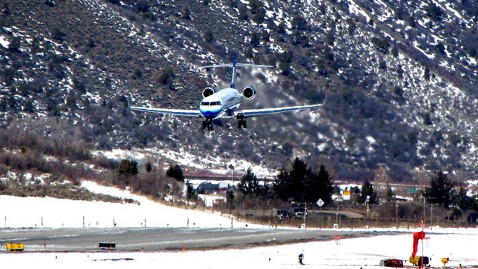10 Scariest U.S. Airports

(Redlegsfan21/Flickr)
Ever grabbed that airplane armrest a little tighter during landing? Ever felt as if you were taking of in a space shuttle instead of an Airbus? Well, you may have been taking off or landing at one of the scariest airports in the country.
Just in time for summer, one of the busiest flying seasons of the year, Airfarewatchdog.com, part of the Smarter Travel Media Network, has released its picks for the scariest airports in the United States.
"We really don't want to scare people from flying, so maybe we should call these the most "thrilling" airports to land at. Air travel, mile for mile, is still the safest way to get from place to place, other than, perhaps, your own two feet," George Hobica, travel journalist and founder of Airfarewatchdog.com, said in a statement.
Aspen/Pitkin County Airport, Aspen, Colo.
Every winter, snow bums and bunnies head out to Aspen to hit the mountains, but be warned when touching down at this snowy airport. Pilots must be certified to land in Aspen. Airfarewatchdog.com suspects this is because the airport requires a swift descent at high altitude.
John Wayne Airport, Santa Ana, Calif.,
A unique takeoff is required at this sunny airport. Because of strict noise restrictions, pilots must take off at maximum throttle and then abruptly pull back on their engines. Some have compared taking off at this airport to a "ballistic missile" and a "space shuttle liftoff."
Midway International Airport, Chicago
Although Midway isn't quite as busy as its sister airport, O'Hare, that doesn't make it any less scary. The runways at Midway are close to 2,000 feet shorter than those at newer airports, causing many pilots to overshoot takeoff and landing. In 2005, a Boeing 737 barreled through the airport fence and crashed in the middle of a major highway after skidding on the runway. The crash killed a 6-year-old boy and injured a dozen others.
Sitka Rocky Gutierrez Airport, Sitka, Alaska
The name says it all. This airport can get a little rocky. It's almost completely surrounded by water in the Sitka Sound and weather can get a little crazy, so pilots have to watch out for boulders and debris that often wash from the causeway onto the island's only runway. Large flocks of birds also live close to the airport and are frequently spotted in the skies.
Yeager Airport, Charleston, W. Va.
Yeager is another short runway, but what makes this airport a bit more thrilling is that it sits atop a flattened mountain. The runway sits between two cliffs so passengers better hope their pilot doesn't overshoot this runway. In January 2010, one pilot overran the runway following a rejected takeoff. Luckily, the plane was stopped by the Engineered Materials Arrestor System at the end of the runway before it plunged over a cliff. Although no one was hurt, the plane sustained significant damage.
San Diego International Airport, San Diego
This downtown airport is considered one of the most dangerous, according to Airfarewatchdog.com. With mountains to the north and east, Mexican airspace to the south and strong tailwinds blowing in from the west, pilots better watch out. All of these factors combined sometimes force nose-to-nose takeoffs and landings.
LaGuardia Airport, New York
Although the views of the Empire State Building are breathtaking during takeoff and landing from LaGuardia, this airport sits a little too close to the Manhattan skyline. It is also one of three airports in the country's largest airport system so the skies around LaGuardia are packed with jets. During landing, pilots are forced to make a series of tight, low altitude turns, including an 180-degree turn around Citi Field. Let's also not forget one of the most famous crashes that started at LaGuardia, US Airways flight 1549, which landed in the Hudson River after hitting a flock of birds and losing both engines. No worries though. All 150 passengers and five crew members were plucked from the Hudson safe and sound.
Catalina Airport, Avalon, Calif.
Get ready for a bumpy landing if you're flying into this California airport. Catalina Airport has an altitude of 1,602 feet, dubbing it the Airport in the Sky, and is known to have downdrafts and turbulence on approach. Additionally, the runway drops off so much on both sides that pilots at one end of it can't see planes at the other. And to add to that, the runway is also rough with potholes and soft spots caused by heavy rains.
Telluride Regional Airport, Telluride, Colo.
The highest commercial airport in the United States, its runway sits on a plateau above the San Miguel River and dips in the middle. But pilots only have one shot at landing at this snowy airport because touch-and-go landings are prohibited.
Reagan National Airport, Washington, D.C.
Pilots have to be especially skilled to fly into this difficult airport. Reagan National sits between two overlapping no-fly zones, so pilots have to watch out for the Pentagon and CIA headquarters. And on takeoff, pilots must ascend quickly and sharply turn left so they don't fly over the White House. After the attacks of Sept. 11, security forces strongly enforce these rules.